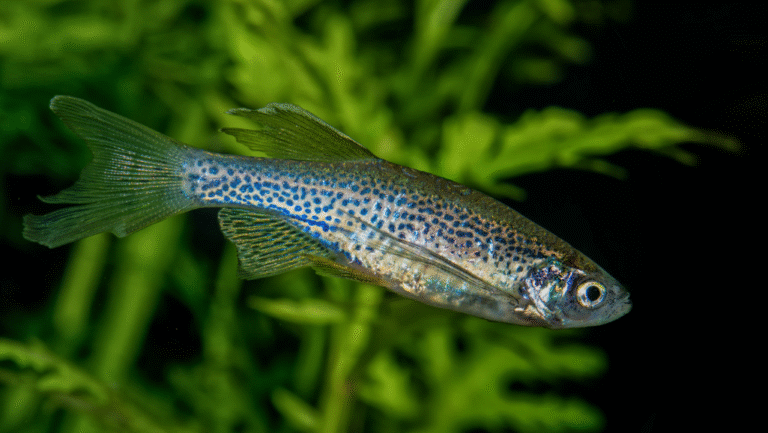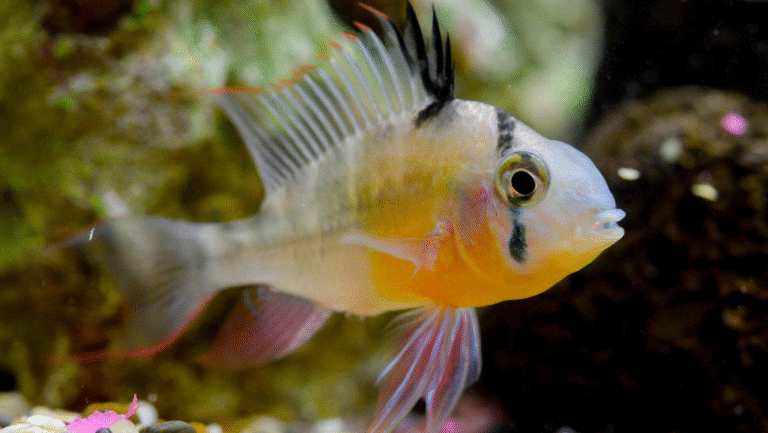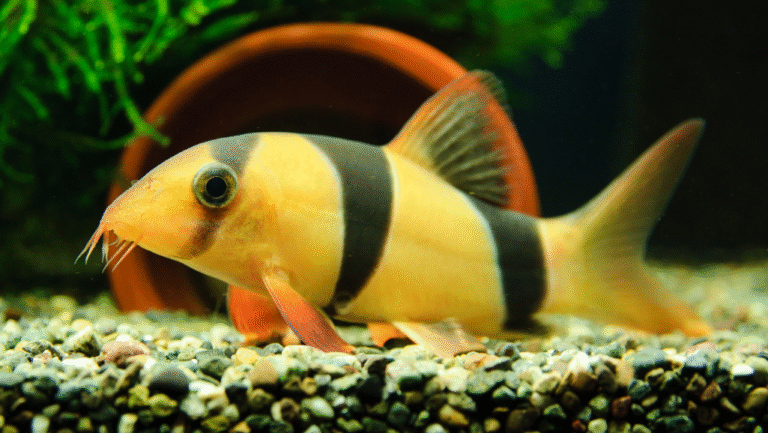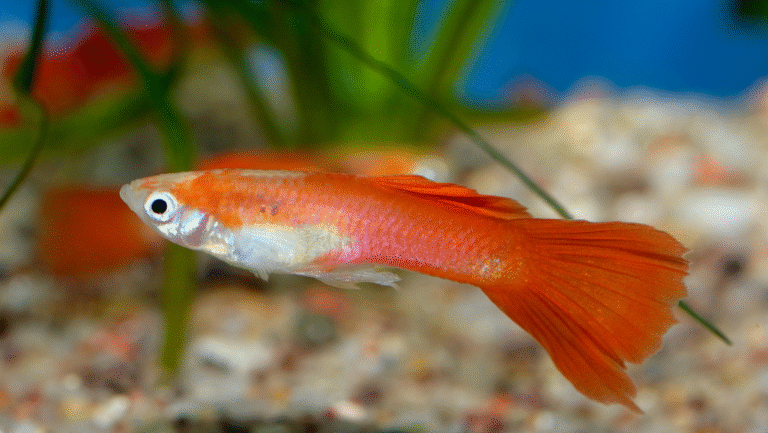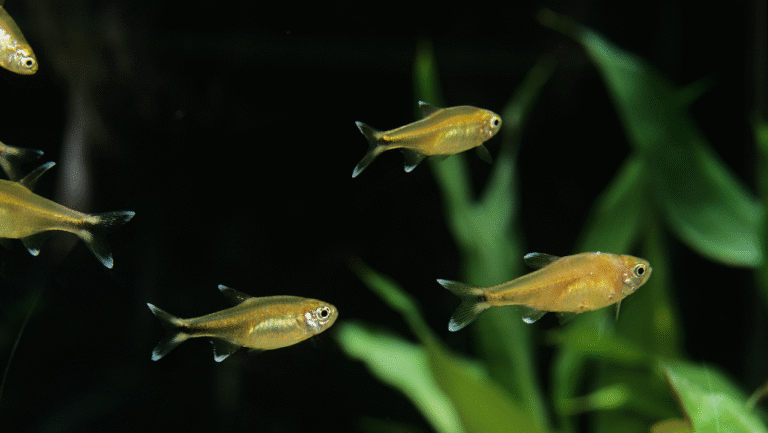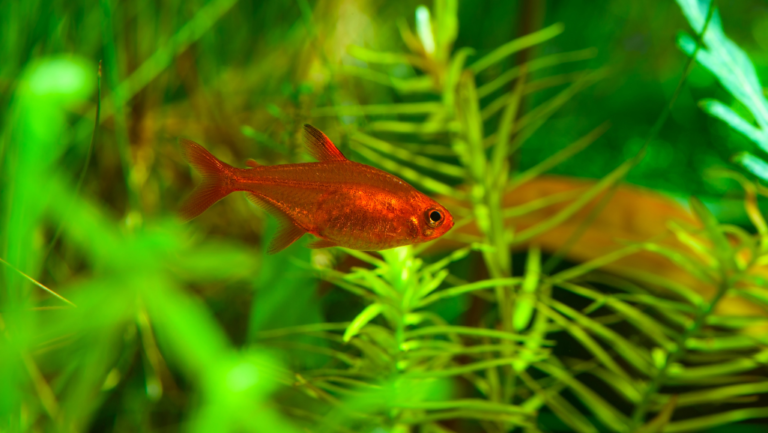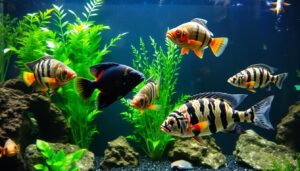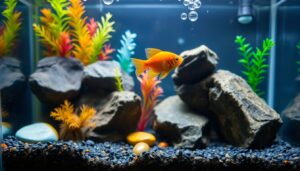Watch a schooling glass catfish display and you get a living light show. Translucent bodies glide in midwater, bringing calm motion to planted tanks. These peaceful fish come from Southeast Asia and reward steady care more than flash. They live about 7–8 years with proper routines.
In this guide you will learn tank size, stable water needs, aquascape tips, feeding, compatible tankmates, health safeguards, and rare breeding notes. Aim for at least a 30-gallon aquarium with gentle flow and soft, slightly acidic water near 76°F.
They thrive in groups. Plan for several to boost confidence and natural schooling. These scaleless species need careful acclimation and steady parameters to avoid ich and stress. A varied diet of quality flakes, pellets, and frozen or live foods builds strong immunity.
Key Takeaways
- Translucent midwater schooling adds calm motion to community tanks.
- Provide a 30+ gallon aquarium with soft, slightly acidic water and stable temperature.
- Keep them in groups and use live plants and subdued light for best display.
- Feed varied diets of flakes/pellets plus frozen or live foods for conditioning.
- Scaleless species are sensitive to parameter swings; steady routines matter most.
Meet the Glass Catfish: What Makes These “Ghosts” So Mesmerizing
Understanding which species you own changes how you care for these near-invisible swimmers. The name on a store tag can shape feeding, tank size, and social needs. Learn the identity and anatomy so you can provide the right home.
True identity: vitreolus vs. kryptopterus bicirrhis
“Before 2013 most hobby specimens were mislabeled; careful research showed the common aquarium species is K. vitreolus.”
Most fish sold as “glass catfish” are actually Kryptopterus vitreolus. The often-cited kryptopterus bicirrhis is larger (about 6 inches), less transparent, and more assertive. A dwarf form, K. minor, appears rarely in trade.
Transparency explained: anatomy and hidden fin
The genus kryptopterus name means “hidden fin,” a nod to the reduced dorsal fin that gives these fish a ghostly profile.
With truly clear bodies you can see the skeleton, eyes, and a silvery organ sack behind the head. After a big meal the digestive tract may be visible — a living biology lesson in your tank.
- Most hobby specimens are K. vitreolus (≈3 inches, gentle).
- K. bicirrhis reaches ~6 inches and is semi-opaque and bolder.
- Transparency is natural — not caused by dyes or treatments.
For more on identification and care, consult a detailed species guide like this practical reference. With ID clarified, you can tailor habitat and community choices confidently.
Glass Catfish
Native southeast asia streams shape how these fish behave and how you should set up their tank.
Native habitats and schooling behavior
K. vitreolus commonly enters the trade via Thailand and lives in small, slow coastal streams with soft, slightly acidic water. These areas hold leaf litter, dense plants, and driftwood that offer shade and shelter.
In the wild they form huge schools—dozens to hundreds—sweeping from cover into open lanes to hunt tiny crustaceans and insect larvae. This group movement makes them bold and synchronized when kept together.
They are true midwater swimmers, so they remain visible and active rather than hiding on the bottom. A steady ~76°F mirrors their natural temperature and keeps feeding and activity regular.
- Anchor tank design to shaded streams and plant-rich margins.
- Plan both covered areas and open swim corridors to mirror their wild flow.
- Keep a healthy group for confident, natural schooling and display.
For species identification and more on wild range, see a dedicated profile on K. vitreolus.
Setting Up the Ideal Glass Catfish Tank
Creating roomy swim corridors and shaded cover is the first step to calm, confident schooling. Design your aquarium to echo slow tropical streams so shy swimmers feel safe and display naturally.
Size and layout that encourage schooling
Start with at least a 30-gallon tank to provide stable conditions and true midwater space. Frame open swim lanes with dense plants and branching driftwood to create both cover and showy corridors.
Water, parameters, and gentle flow
Keep temperature near 76°F, pH in the high 5s to neutral, and soft water around 2–6 dKH. These water parameters reduce stress and encourage steady activity.
Use a power or canister filter with an adjustable output. Aim for a gentle to moderate current that mimics a sheltered stream. Avoid strong blasts that force frantic swimming.
Lighting, substrate, and hiding design
Choose subdued lighting and add driftwood or leaf litter to create tannin-stained water. This soothes timid fish and highlights their translucent bodies.
- Select smooth sand or fine gravel to protect delicate barbels and support plants.
- Build multiple hiding spots among roots and rock shadows so schools can retreat when startled.
- Keep dark backgrounds and clear midwater lanes to reduce reflections and stress.
Stability matters most: precondition new water and test regularly. A calm, consistent environment is the best investment for long-term success in a freshwater aquarium.
Daily Care Routines: Water Quality, Stability, and Monitoring
Daily checks and gentle maintenance build the stability these transparent swimmers need to thrive. Make a short, repeatable routine and stick to it. Consistency lowers stress and supports long lives measured in years.
Test key values weekly: check ammonia, nitrite, nitrate, pH, and hardness. Keeping these water parameters steady prevents sudden shocks that sensitive fish feel immediately.
Acclimate new arrivals slowly using drip or bucket methods. Quarantine new fish in a separate aquarium for observation to stop hitchhiking parasites from reaching your display.
“Small, steady steps in maintenance save time and heartache later.”
- Make weekly testing your habit to catch tiny shifts early.
- Do regular partial water changes to export nitrates and restore minerals.
- Keep a simple log of maintenance information so patterns become obvious.
- Clean filters on schedule but avoid over-sanitizing to protect beneficial bacteria.
- Feed lightly and on a routine; less waste means clearer water and calmer schooling.
Watch behavior closely: clamped fins, constant hiding, or sudden darting often flag poor chemistry or temperature swings. Stable room and tank temperatures, plus avoidance of direct sunlight and drafts, also help keep the environment steady.
Feeding Your Glass Catfish for Health and Longevity
Match feeding to natural prey and you’ll see steady growth and lively schooling. In the wild they eat zooplankton, tiny crustaceans, and insect larvae, so mimic that with small, protein-rich food in the aquarium.
Natural diet vs. aquarium substitutes
Focus on fine prey analogs. Offer micro flakes or high-quality micro pellets as a daily base. Supplement with live or frozen brine shrimp, daphnia, and bloodworms to recreate variety and nutrition.
Feeding frequency and portion control
Feed 2–3 light meals per day. Use bite-sized portions that finish within a couple of minutes to protect water quality. These small fish have tiny mouths, so small pieces matter.
- Mirror the wild: micro pellets/flakes plus daphnia, bloodworms, and brine shrimp.
- Rotate textures: pellet, frozen, and live to maintain interest and body condition.
- Target-feed: drop food into the schooling zone so shy individuals eat.
- Enrich frozen foods: add vitamins occasionally to support immunity.
- Watch bellies: a gentle fullness shows proper size and pacing—avoid overfeeding.
“Consistency in feeding builds boldness and keeps condition steady.”
Choosing Peaceful Tankmates and Building a Harmonious School
A confident school begins with the right numbers and gentle neighbors in the aquarium. Start by committing to a proper group size and then add calm companions that share midwater habits.
How many to keep: Keep at least six glass catfish to unlock true schooling behavior. Larger groups increase confidence and produce better synchronized movement that delights viewers.
Compatible companions
Pick peaceful aquarium fish that won’t bully or outcompete this group. Good choices include ember tetras, harlequin rasboras, small Corydoras, and gentle honey gouramis.
Species to avoid
Avoid large or boisterous fish such as big cichlids and racing barbs that chase midwater swimmers. These aggressive tankmates stress the school and reduce visible activity.
“The harmony of the group is the heartbeat of a successful display tank.”
- Commit to a minimum group of six to unlock schooling behavior.
- Provide roomy swim lanes and reliable hiding spots so the school can reset after scares.
- Feed midwater-friendly foods to prevent competition from surface or bottom feeders.
- Watch interactions after additions and rehome fish that nip or crowd the school.
Health, Sensitivities, and Rare Breeding Notes
Preventing disease and recognizing early signs of stress keeps these delicate swimmers thriving.
Scaleless species are vulnerable. Their skin offers less protection, making them prone to ich and rapid irritation. With steady care, many reach 7–8 years and reward patient keepers.
Common issues and medication cautions
Watch for flashing, white spots, and clamped fins. These signs signal parasites or poor water chemistry and demand quick action.
Avoid harsh remedies: malachite green and other strong formulas can harm scaleless bodies. When medication is needed, choose options known to be tolerated by sensitive species.
Quarantine and gentle treatments
Quarantine new arrivals to buy time for observation and early treatment. First-line ich response is to raise temperature carefully to around 88°F to speed parasite life cycles.
If drugs are required, precisely dosed copper-based treatments are often effective and safer than many alternatives. Track dosing and water changes closely to protect both stock and beneficial bacteria.
Breeding reality and fry care
Breeding is rare and usually accidental. These fish are egg scatterers with few documented spawns in the aquarium trade. Albino variants sometimes appear from trade sources in Thailand.
If fry appear, begin with infusoria, then move to baby brine shrimp as they grow. Small, frequent feedings and stable water make the difference in survival time.
- Treat them like sensitive species: quick quarantine and gentle care.
- Start ich response: raise heat, then consider measured copper therapy if needed.
- Expect surprises: breeding is uncommon; successful fry require tiny foods and steady water quality.
Conclusion
A well-kept K. vitreolus school rewards patience with hypnotic midwater motion and near-transparent beauty.
Keep at least six in a 30+ gallon tank with subdued light, driftwood, and plenty of plants. Aim for gentle flow and stable water near 76°F with soft, slightly acidic parameters to reduce stress.
Feed small, frequent portions—micro pellets, daphnia, and a touch of brine shrimp—to maintain condition without fouling the aquarium. Quarantine new arrivals and treat ich first with careful heat; use copper only when needed and dosed precisely.
Adults reach about 3 inches, show a hidden dorsal fin, and display organs through clear bodies. With steady routines and compatible tankmates, this genus Kryptopterus species turns a home tank into living art.







